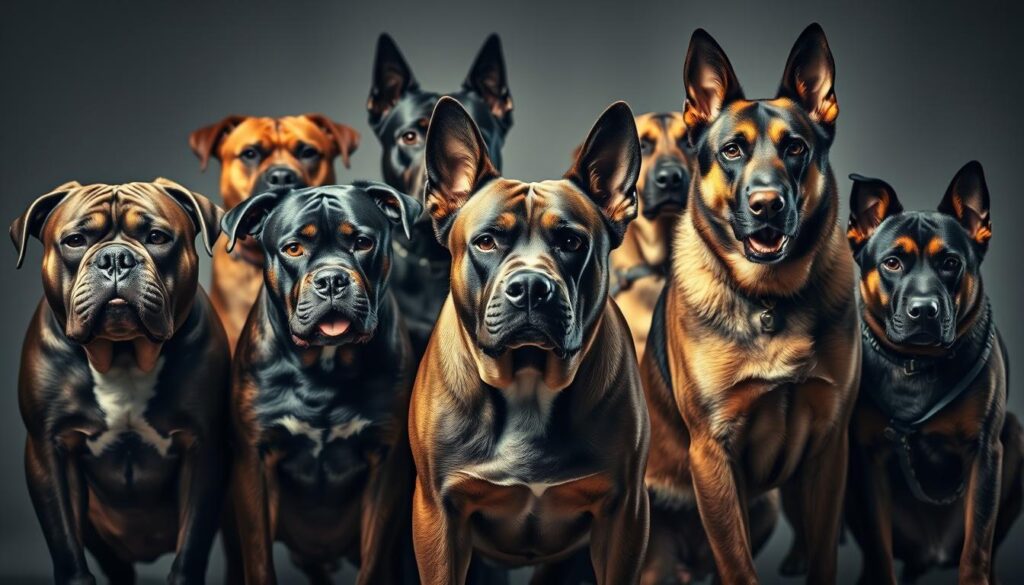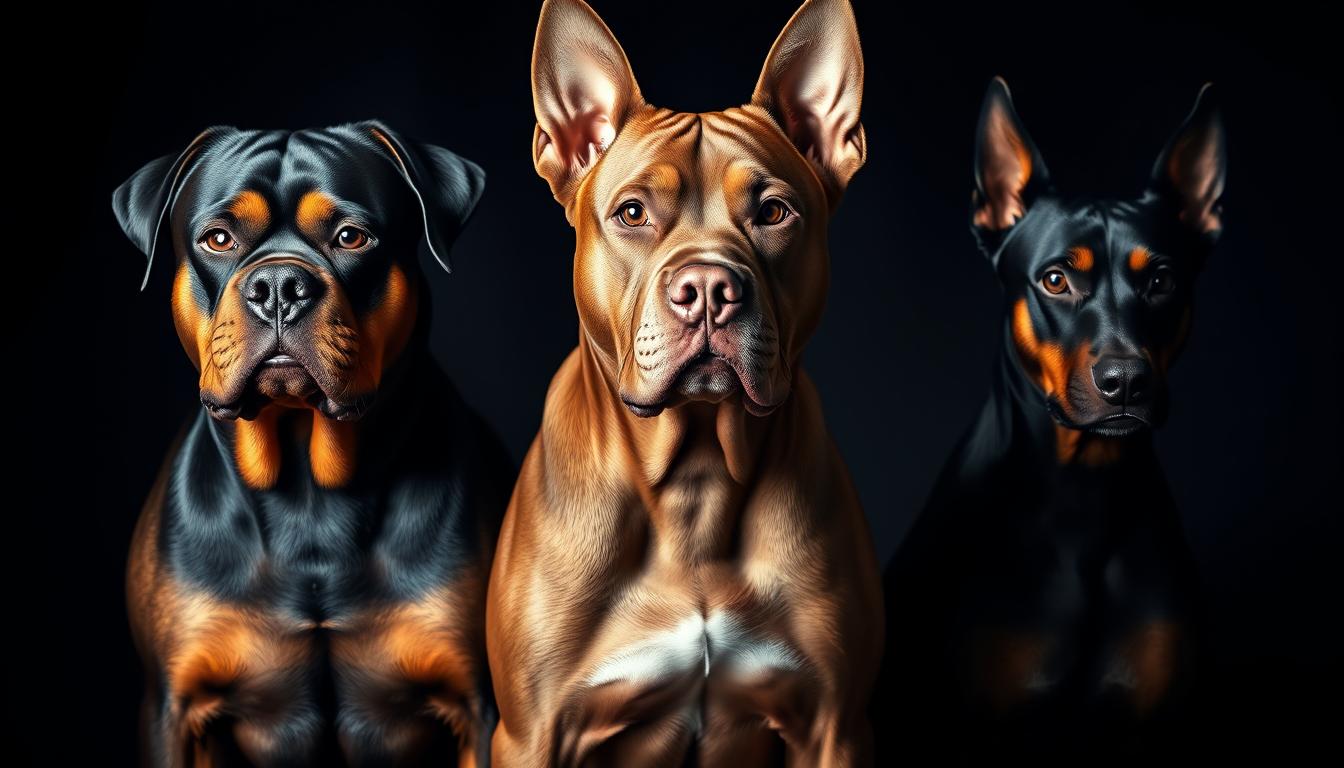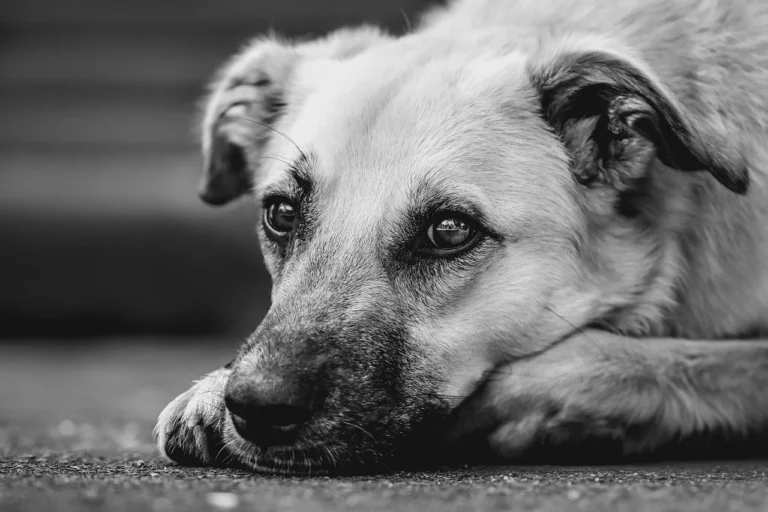Scary Looking Dogs Myths vs Facts: 10 Things You Should Know
Growing up, I saw how people would avoid our big Rottweiler. Despite his friendly nature, his size scared them. This taught me how scary looking dogs are often misunderstood.
Dog breeds are often judged by how they look, not their true nature. Many breeds face unfair stereotypes. This stops people from seeing their loving side.
Looking beyond what dogs look like is key. Each breed has its own personality. Learning about their background can change how we see them.
This article will uncover the truth about scary looking dogs. We’ll look at breed traits, behavior, and the importance of good ownership. This helps shape a dog’s personality.
By the end, you’ll see intimidating dog breeds in a new light. You’ll understand why judging a dog by looks is wrong.
Table of Contents
Understanding Intimidating Dog Breeds
Dog breeds are often seen as scary or dangerous. But the truth is more complex. Spooky dog looks can hide a dog’s true nature. Many dogs that seem scary are actually gentle and misunderstood.
Physical Characteristics That Create Fear
Certain traits can make dogs seem intimidating. These include:
- Large muscular body structure
- Prominent jaw lines
- Deep-set eyes
- Thick, robust build
- Darker coat colors
The Role of Media in Breed Perception
Media shapes how we see scary-looking dogs. Movies, news, and TV often show certain breeds as aggressive. This creates lasting stereotypes about frightening canines.
Common Misconceptions About Large Dogs
Size doesn’t mean a dog is aggressive. Many large breeds are gentle, patient, and great with families. We should judge a dog’s behavior based on its temperament, training, and socialization, not just its size.
“Judge a dog by its character, not its looks” – Canine Behavior Experts
Understanding dog breeds requires an open mind. We must look beyond their scary looks. Each dog has its own personality, which can’t be guessed by breed stereotypes.
The Science Behind Dog Behavior
Understanding dog behavior is more than just knowing about breeds. Menacing dog breeds often get a bad rap, but science shows a more complex story of dog psychology. Your dog’s personality is shaped by many factors, not just genes.
Researchers have found key things that affect dog behavior:
- Genetic inheritance
- Early socialization experiences
- Individual personality traits
- Environmental interactions
- Training methods
Eerie dog looks can be misleading when judging a dog’s behavior. Studies show that individual personalities within breeds matter more than breed stereotypes.
| Behavioral Influence | Impact Percentage |
|---|---|
| Genetics | 30% |
| Early Socialization | 25% |
| Training | 25% |
| Environment | 20% |
Today’s research on dog behavior highlights the importance of environment and training. Responsible ownership is key in shaping a dog’s behavior, not just breed or looks.
Understanding dog behavior requires looking beyond superficial characteristics and recognizing the complex interplay of genetic, environmental, and social factors.
Most Commonly Misunderstood Scary Looking Dogs
Dog breeds with unsettling features often get a bad rap. Many creepy dog breeds are misunderstood. Their looks create unnecessary fear in people. Knowing these breeds beyond their looks can help break harmful stereotypes.
Some dog breeds are seen as dangerous because of how they look. Their strong builds, jaws, and intense stares can scare people. But, these dogs are not as scary as they seem.
Pit Bulls and Bully Breeds
Pit bulls are often misunderstood. Despite their tough image, they are:
- Incredibly loyal to their families
- Highly trainable
- Emotionally sensitive
- Eager to please their owners
Rottweilers and German Shepherds
These working breeds are unfairly seen as aggressive. But, they are:
- Intelligent and responsive to training
- Protective of their families
- Capable of gentle companionship
- Excellent service and working dogs
Dobermans and Great Danes
Large dogs with strong builds often scare people. But, Dobermans and Great Danes are usually gentle giants. They can be loving, patient, and great with kids if socialized and trained right.
The key is understanding that a dog’s looks don’t define its personality. Good ownership, early socialization, and training are key to a dog’s behavior.
Nature vs. Nurture in Dog Temperament

When we talk about scary looking dogs, it’s important to remember that breed is just one part of the puzzle. Every dog is unique, shaped by both their genes and their environment.
The debate on nature vs. nurture in dog behavior is really interesting. Genetics do play a big role, but they’re not everything. A dog’s experiences, training, and how they interact with others greatly shape their personality and actions.
“A dog’s character is not predetermined by its breed, but by the love, guidance, and environment it experiences.” – Dr. Victoria Stilwell, Animal Behaviorist
Key Factors Influencing Dog Temperament
- Genetic inheritance
- Early socialization experiences
- Quality of training
- Owner’s behavior and leadership
- Environmental stimuli
Professional dog trainers say that consistent, positive training can change even the most intimidating dog breeds. Nurturing matters more than natural instincts.
How you raise a dog has a bigger impact on its temperament than its looks or breed. With patience, understanding, and dedicated training, you can make any dog confident and balanced. It doesn’t matter if they look scary or not.
Breaking Down Breed-Specific Stereotypes
Spooky dog appearances can often mislead people about a canine’s true nature. Many frightening canines are misunderstood. Their behavior is shaped more by environment and training than by breed characteristics. Understanding the complex factors that influence dog temperament helps break down harmful stereotypes.
Training and Socialization Impact
Your dog’s behavior is not predetermined by breed alone. Proper training and early socialization play crucial roles in shaping a dog’s personality and interactions. Dogs exposed to positive experiences and consistent training develop:
- Better emotional regulation
- Improved social skills
- Reduced aggressive tendencies
- Enhanced adaptability
Environmental Factors
The environment significantly influences a dog’s temperament. Factors like living conditions, family dynamics, and exposure to different stimuli can dramatically impact how a dog perceives and responds to the world around them.
The Role of Responsible Ownership
Responsible ownership is the cornerstone of raising a well-adjusted dog. By understanding your dog’s needs, providing consistent training, and creating a supportive environment, you can help transform potentially frightening canines into loving companions.
“A dog’s behavior is a reflection of its upbringing, not its breed.” – Professional Dog Trainer
Ultimately, breaking down breed-specific stereotypes requires education, empathy, and a commitment to understanding each dog as an individual.
The Truth About Guard Dog Breeds

Guard dog breeds often get a bad rap for their scary looks and seeming aggression. It’s important to look beyond the surface and see their true nature and potential.
Many people think guard dogs are always dangerous. But, these dogs are smart and have strong protective instincts. With the right training and socialization, they can be wonderful companions.
- Guard dogs are bred for specific protective purposes
- Eerie dog looks do not determine a dog’s temperament
- Professional training transforms potential aggression into controlled behavior
Breeds like German Shepherds, Doberman Pinschers, and Rottweilers are often misunderstood. Their strong bodies and serious looks make them seem intimidating. But, these traits can be managed well.
| Breed | Protective Traits | Training Difficulty |
|---|---|---|
| German Shepherd | High intelligence, strong loyalty | Moderate |
| Doberman Pinscher | Quick learning, alert nature | High |
| Rottweiler | Powerful physique, protective instinct | Moderate to High |
How you treat these dogs is key. With regular training, socialization, and understanding, guard dog breeds can be exceptional family companions. They offer both protection and love.
How to Approach and Interact with Intimidating Dogs
Meeting dogs with unsettling features can be scary for many. Knowing how to safely interact with them is key. Your approach can greatly affect the outcome of the interaction.
Dogs talk through body language, which is vital to understand their feelings. Spotting subtle signs can guide you through interactions with dogs that might seem intimidating.
Reading Canine Body Language
- Watch for ear position and tail movement
- Observe overall body tension
- Notice eye contact and facial expressions
- Pay attention to breathing patterns
Safe Interaction Techniques
- Approach slowly and calmly
- Avoid direct eye contact
- Keep your body sideways to appear less threatening
- Let the dog approach you
| Body Signal | Meaning | Recommended Action |
|---|---|---|
| Stiff body | Potential aggression | Maintain distance |
| Relaxed posture | Comfortable | Gentle interaction |
| Tucked tail | Fear or anxiety | Slow, non-threatening approach |
Building Trust and Rapport
To connect with dogs, show consistent, gentle behavior. Speak softly, move predictably, and never force interaction. Respect their space and let them feel safe with you.
Even dogs that seem creepy can be gentle and loving. Approach them with understanding and care.
Debunking Popular Myths About Scary Looking Dogs
Myths about scary looking dogs are common. Many breeds face unfair stereotypes. These myths don’t show the truth about these dogs.
“Judge each dog as an individual, not by breed stereotypes.”
Here are some myths about intimidating dog breeds:
- Myth: All pit bulls are inherently aggressive
- Myth: Large dogs are dangerous around children
- Myth: Certain breeds cannot be trained or socialized
Studies show that a dog’s behavior depends on training, socialization, and environment. Scary looking dogs are often misunderstood. Experts say a dog’s breed doesn’t decide its temperament.
| Breed | Common Myth | Actual Temperament |
|---|---|---|
| Pit Bulls | Aggressive and unpredictable | Loyal, affectionate, trainable |
| Rottweilers | Dangerous around families | Protective, gentle with proper training |
| German Shepherds | Too intense for home environments | Intelligent, adaptable, great family dogs |
How you understand intimidating dog breeds is important. Responsible ownership, early socialization, and positive training techniques are crucial. They help any dog become well-adjusted, no matter the breed.
Conclusion
Dogs with scary looks often get judged unfairly. Understanding them can change how we see these breeds. It’s important to know that a dog’s behavior comes from training, socialization, and its own personality.
Spooky looks don’t mean a dog is scary. Learning about different breeds and treating them with respect can lead to deep connections. Tools like the Wisdom Panel™ dog DNA test can give you insights into your dog’s background and traits.
Education is the best way to fight breed myths. By sharing true facts and challenging old beliefs, we can make a better world for all dogs. Remember, being a good owner, training your dog well, and getting to know it as an individual are key.
Do something today: question your beliefs about scary dogs, learn about various breeds, and spread the word. Your knowledge can greatly change how society views and treats these amazing pets.







